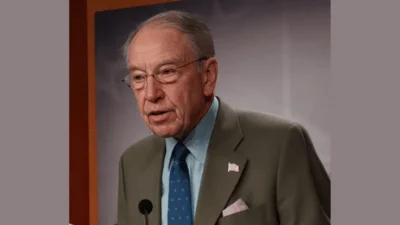The Congressional Record is a unique source of public documentation. It started in 1873, documenting nearly all the major and minor policies being discussed and debated.
“HEROIN CRISIS STARTS IN COLOMBIA” mentioning the U.S. Dept of State was published in the Extensions of Remarks section on pages E2127-E2128 on Oct. 13, 1998.
The publication is reproduced in full below:
HEROIN CRISIS STARTS IN COLOMBIA
______
HON. BENJAMIN A. GILMAN
of new york
in the house of representatives
Tuesday, October 13, 1998
Mr. GILMAN. Mr. Speaker, while the Administration has fought the Congress tooth and nail over the last few years to prevent the provision we wanted of high performance (greater lift and range capacity) and crash survivable as well as ballistically hardened helicopters to the Colombian National Police (CNP) excellent DANTI anti-narcotics unit in a real shooting war on drugs, something dramatically has happened on the heroin front here at home.
In the last five years, first time teen (12-17) heroin use has risen a mind boggling 875%, and according to latest DEA seizure and street buy data, 75% of that heroin now comes from Colombia. So while the Administration slept, the Colombian narco-traffickers shifted gears and took over the former Asian dominated U.S. heroin market with cheaper, purer and more deadly South American heroin.
The Washington Times outlined the recent U.S. move towards South American heroin in its edition yesterday in a extensive and comprehensive piece called ``Cocaine Cartels Take on New Product-
Heroin''. The article notes this Colombian heroin on the streets of the U.S. approaches (according to DEA) 70% to 80% purity, while the average of other heroin is only 39% purity. Our DEA, FBI and Customs Service agree that the best place to fight drugs is at the source, and in this case, it's the high Colombian Andes fields of opium poppy, which the native people call the ``devils flower''.
Sadly, the Times piece also notes that in nearby Prince Georges' county here in the Washington area, we have witnessed 42 persons who died last year form heroin overdoses. What's happening abroad, also has consequences here at home.
From the front lines in the high Colombian Andes the news isn't any better. The CNP without high performance helicopters needed to reach the opium poppy fields with enough troops to secure the area for later aerial eradication is seeing more and more poppy. In 1997, according to some Colombian sources we may have had a 1/3 increase in Colombian opium growth, and at best we are only eradicating 1/3 of the small but ever growing and valuable poppy crop. All this means hard times and more overdose deaths in our communities from deadly Colombian heroin.
Mr. Speaker, I request that the Washington Times article dated 10/12/
98 I referenced be included at this point in the Record:
Cocaine Cartels Take on New Product--Heroin
South American suppliers eclipse Asia in burgeoning U.S. market
(By Jerry Seper)
South America's cocaine cartels have moved into a lucrative new market, becoming the dominant force in supplying heroin to a rapidly expanding clientele of eager U.S. buyers--many as young as 15 years old.
The U.S. Drug Enforcement Administration details in a new report that the agency calls a ``dramatic shift'' over the past four years as South American drug traffickers have wrested control of the U.S. heroin market from once-dominant smugglers in Southeast Asia.
About 75 percent of the heroin seized in 1997 throughout the United States originated in South America, and the numbers are expected to rise for 1998. By contrast, 97 percent of the heroin seized in the United States in 1991 came from dealers in Southeast or Southwest Asia, which now accounts for only about 5 percent of the heroin shipped each year into this country.
Most of the increase comes form smugglers in Colombia, with the drug being shipped clandestinely to buyers throughout the country, particularly in Boston; New York; Newark, N.J.; Philadelphia; and Baltimore--a region known as ``Heroin Alley.''
DEA Administrator Thomas A. Constantine said Colombian cartel leaders, working with Mexican-based drug traffickers, have made management decisions over the past four years aimed at increasing their share of the U.S. heroin market.
``The situation we face today, one of high rates of trauma in our hospital emergency rooms and high mortality rates among heroin users, was brought about by strategic management decisions made by both Colombian- and Mexican-based trafficking organizations to increase their respective shares of the lucrative U.S. heroin market,'' Mr. Constantine said.
Of the more than 6 tons of heroin produced in 1997 in Colombia, virtually the entire stock was delivered to buyers in the United States. Colombia, which already supplies about 80 percent of the world's cocaine, has become both a grower and processor of opium poppies in Bolivia and Peru, which are then refined in jungle labs under the protection of highly paid left-wing guerrillas.
Colombia's new president, Andres Pastrana, has vowed to step up his country's fight against drugs--a promise in sharp contrast to efforts by his predecessor, Ernesto Samper, who accepted $6 million from drug smugglers to help finance his 1994 election campaign.
``Traffickers today know no national boundaries and will utilize the latest technologies and delivery systems to enhance their illicit activities,'' Mr. Constantine said, noting that Colombian-based smugglers drew on the expertise of drug chemists in Southwest and Southeast Asia to produce the higher-quality product flooding the East Coast.
Mr. Constantine said Mexican drug traffickers are working with Colombian chemists to increase the purity level of Mexican-produced heroin to ``expand their markets in the United States.''
The DEA report said there are two general U.S. heroin markets:
One centered on the East Coast, supplying a high-purity, white powder heroin that can be snorted as well as injected.
One in the West, specializing in injectable-quality heroin, primarily Mexican black tar.
The Office of National Drug Control Policy has estimated that 810,000 hard-core drug addicts are involved in the use of heroin as their principal drug of choice, and that the high-quality South American product has spawned a new breed of users--those more amenable to snorting rather than injecting the drug.
Records show increasing numbers of young people are becoming involved--particularly in Philadelphia, St. Louis and New Orleans, where about 12 percent of those arrested were between 15 and 20.
Locally, both Montgomery and Prince George's counties have seen the number of addicts entering rehabilitation centers double and triple in recent years, averaging about 500 a year. Prince William County treated about 70 persons for heroin use from July 1997 to June 1998. The total for that period has not yet been tallied for comparably sized Howard County, but authorities expect it to exceed 250.
Last year, heroin overdoses killed 42 persons in Prince George's County.
The DEA has tracked the increasing dominance of South American heroin since 1993 and, according to the report, has found that the purity of the product appears to be its draw. While the national average purity of all heroin is about 38 percent, South American heroin--of that confiscated in New York, Boston, Newark, Baltimore and Philadelphia--registers between 70 and 80 percent pure.
In 1996, Baltimore led the nation in hospital emergency room admissions for heroin overdoses and was second only to San Francisco last year. Of the 401 persons who died of heroin overdoses in Maryland in 1997, 252 fatalities occurred in Baltimore.
The DEA has said that in Baltimore 40,000 addicts pay dealers an estimated $2 million a day for heroin. In the District, there are an estimated 17,000 heroin users, although crack cocaine and marijuana continue to be the drugs of choice.
Mr. Constantine said the agency plans to increase manpower levels and spending totals over the next several years for domestic and international heroin enforcement. He said information collected in hospital emergency rooms, police departments, courts, schools, treatment programs and ``on the street'' shows that heroin consumption in the United States is rising.
``For years, we've seen a hardcore older population of approximately 600,000 heroin addicts,'' Mr. Constantine said.
``Today, we are seeing 11th- and 12th-graders turning to heroin. These `initiates' are, in all likelihood, at the outset of a long, downward spiral into hard-core addiction or death.''
About 14 percent of the heroin seized last year in the United States came from Mexico. Virtually all of it was headed for buyers in Dallas; Houston; Denver; Phoenix; San Diego; Los Angeles; San Francisco; Portland, Ore.; Seattle; St. Louis; and Chicago.
Despite Mexico's continuing involvement in the drug trade, the Clinton administration certified that country this year as a full partner in the war on drugs--meaning it keeps its eligibility for U.S. aid.
The certification came on a recommendation from the State Department. Colombia was among four countries that were decertified, but it continues to enjoy an exemption from the aid cuts. The administration has said that Colombia, along with Cambodia, Pakistan and Paraguay, are too important to U.S. national security to punish.
Southeast Asian traffickers, mainly in Burma, Laos and Thailand, have been squeezed out of the business by South American smugglers, who have seized the market by offering a higher quality heroin at lower prices--even arranging for easy payments.
``Asian groups traditionally demand either sizable down payments or cash on delivery,'' said Mr. Constantine, noting that Colombia distributors ``often provide drugs on consignment or offer credit.
``Given their reputation for strict enforcement of drug deals, few buyers dare risk reneging on a drug deal with criminal organizations operating from Latin America,'' he said.
____________________








